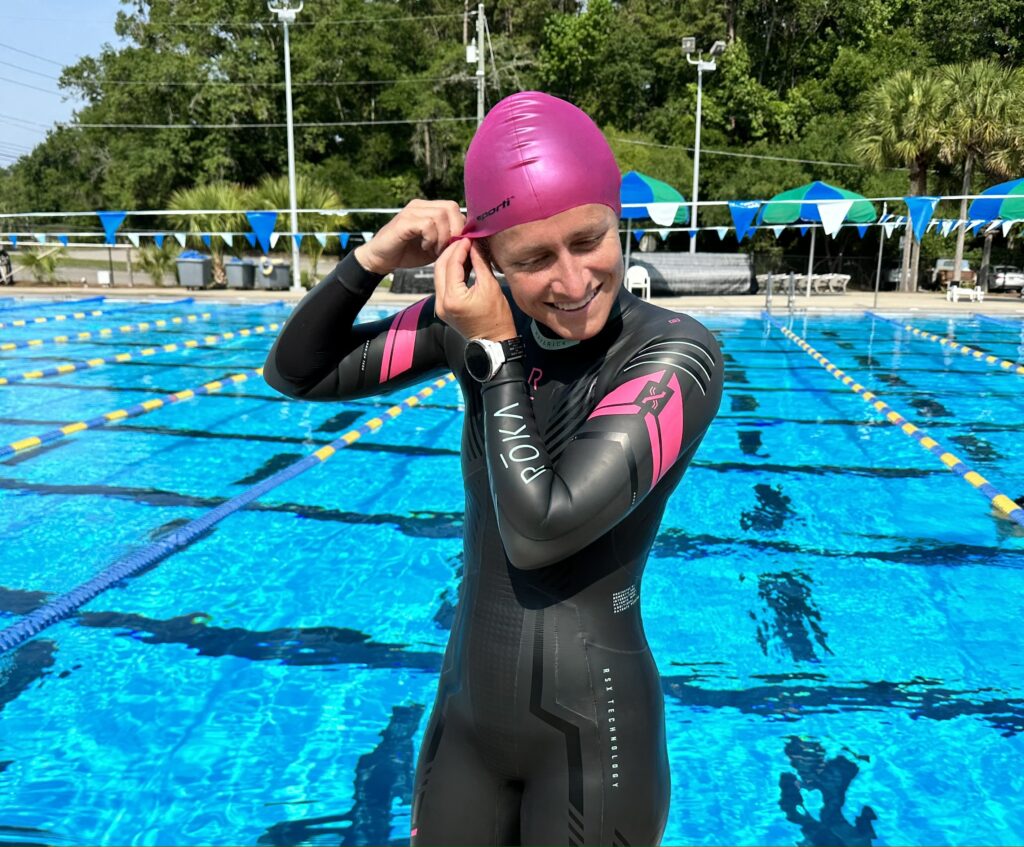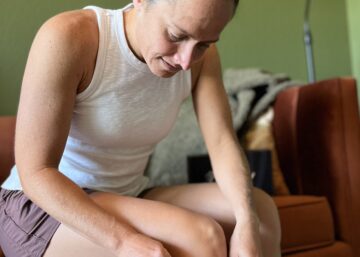
I’m super excited because I received a special delivery this week from my friends at ROKA… It’s a new Maverick X2 wetsuit!
This is actually my first ever, full sleeve wetsuit. For the past three years competing in triathlon, I’ve used the sleeveless variety. It’s been great, but it’s an entry level model, probably a couple hundred bucks. Still, I didn’t think I would feel that much of a difference with this fancy, new wetsuit. I mean, it’s just a wetsuit… Right?
I was wrong. It’s AMAZING! I’m not sure why I thought all wetsuits were created equal when bikes, trisuits, and running shoes certainly aren’t. Just like when I started in triathlon, I had a Trek road bike with clip on aero bars. Now, I have a Felt IA, carbon fiber, triathlon bike with Ultegra Di2 and Boyd race wheels. There’s a difference.

I actually got the chance to try out the Maverick X2 when I borrowed my husband’s wetsuit for Chattanooga 70.3 a few weeks ago. It was a little too big and too tall, but I loved swimming in it, so I was super excited to get one in my size! After doing a bit of research, I discovered that ROKA actually sizes their wetsuits by height and weight, and they have more sizes available for women than men, because women have a wider range of body types. As soon as I pulled the wetsuit out of the box, I could tell that it was constructed differently. There’s more room in the hips, a smaller waist, and narrower shoulder than the men’s suit.
It’s buttery soft, especially in the upper arms, which means zero shoulder restriction. This also has to do with the way they patterned their wetsuits, with the arms up, just like your body is oriented while swimming. I’m really glad they included a pair of gloves so I can prevent fingernail tears when putting the wetsuit on, because it’s SO soft.
 Another great feature is that each wetsuit comes with a series of numbers that are located on specific parts of the body. For example, there are #1s on the knee, #2s on the inside of the elbow, and #3s on the top of the shoulder. This is so you can make sure you’re putting the wetsuit on properly.
Another great feature is that each wetsuit comes with a series of numbers that are located on specific parts of the body. For example, there are #1s on the knee, #2s on the inside of the elbow, and #3s on the top of the shoulder. This is so you can make sure you’re putting the wetsuit on properly.
TIP: The most important thing to do when putting on a wetsuit is to pull the leg panels past the knee and slowly work your way up so you get the crotch in the right position. This is what will ensure there isn’t any restriction in the upper body or pulling on the neck of the suit
 As soon as I jumped in the water, I could tell a big difference in buoyancy. I floated! Apparently, this model has 7% more buoyancy for extra lift in the water, so I wasn’t imagining things. It also has new front, lateral core panels for snappy rotation.
As soon as I jumped in the water, I could tell a big difference in buoyancy. I floated! Apparently, this model has 7% more buoyancy for extra lift in the water, so I wasn’t imagining things. It also has new front, lateral core panels for snappy rotation.
The other thing that’s really interesting is the seven different liners with different stretch profiles that create a type of core exoskeleton. There’s also strategically placed support taping that helps with body alignment. All of this is supposed to support a more efficient body position in the water and maximum power transfer from hip to shoulder.
Something I really like is the stretch woven textile that’s on the inner forearm of the suit. It helps with proprioception, or how you “feel” the water.
Another cool thing is the quick release ankle panels that help with a fast transition.
TIP: I use Body Glide when I wear a wetsuit, but more for ease of removal than for help getting the wetsuit on. The instructions that came with my wetsuit said if the fit is correct, it should take 10-12 minutes to put the wetsuit on properly, and you should need help to zip it up.
 I only swam 500 yds in the suit, because I wanted to avoid any chlorine damage, but I wanted to keep swimming because it felt AMAZING! It’s almost like you slide through the water with hardly any resistance. It’s what I would imagine being a dolphin or a seal feels like. Because I’m a bit of a nerd, I did some research on this as well and discovered that the feeling is due the limestone-based Yamamoto neoprene that’s treated with a SCS (super composite skin) hydrophoboic nano coating… That’s a mouthful! Basically, it’s supposed to reduce surface drag and improve durability.
I only swam 500 yds in the suit, because I wanted to avoid any chlorine damage, but I wanted to keep swimming because it felt AMAZING! It’s almost like you slide through the water with hardly any resistance. It’s what I would imagine being a dolphin or a seal feels like. Because I’m a bit of a nerd, I did some research on this as well and discovered that the feeling is due the limestone-based Yamamoto neoprene that’s treated with a SCS (super composite skin) hydrophoboic nano coating… That’s a mouthful! Basically, it’s supposed to reduce surface drag and improve durability.
After my swim, I rinsed off the wetsuit in cold water and let it dry, inside out, before turning it back right side out to hang up in the closet. I don’t hang up a wetsuit like you would a shirt, because I don’t want the neoprene to stretch out over time. I lay it over the bottom part of the hanger, much like you would a pair of dress pants.
I’m so excited to get to race in this suit at Augusta 70.3 and IRONMAN Florida this year!
Thank you ROKA!


